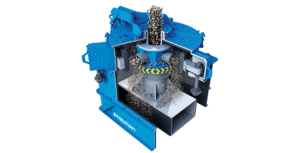Author
The 5 hazardous co-workers around crushers
Working alongside impact crushers and other key quarry equipment is dangerous when the wrong attitude is brought to the task. Keep Reading
VSI crushers maximize first-pass yields, lower operating costs
All roads, you might say, lead to the vertical shaft impactor (VSI) because these crushers make it possible to create roadways and just about everything else. Francis E. Agnew of California patented one of the first VSIs in 1927. His configuration stacked three of them on top of each other to produce sand, thus beginning the evolution of the VSI. Today, innovators have created many VSI configurations to include everything from the addition of cascading material into the crushing chamber, to air swept separation of lighter product. VSIs apply a large amount of energy to crush material and that is why they are one of the most versatile crushers today. When it comes to producing materials such as aggregate for road making, VSI crushers use a high-speed rotor and anvils for impact crushing rather than compression force for the energy needed for size reduction. In a VSI, material is accelerated by centrifugal force by a rotor against the outer anvil ring. It then fractures and breaks along natural faults throughout… Keep Reading
Reduction ratios of cage mills
Cage mills have a high ratio of size reduction after a single pass through the cages. One of the most versatile size reduction machines and one of the hardest working is the cage mill. There are several kinds of cage mills, but their similarities are more numerous than their differences. They are all internally fed impactors that can crush, grind or pulverize many different materials to specified degrees of fineness. By 1900, Nathan Stedman had built more than 100 cage mills designed exclusively to crush coal. Other applications were discovered soon after that time, leading to the increased use of cage mills for crushing chemicals, clay, fertilizer and other products. Multiple-row cage mills – two-, four- and six-row – were common. In the 1930s, the true value of cage mills in the production of ag limestone and the crushing and beneficiation of stone and gravel was realized. Single-row cage mills were used extensively in the construction of the Pennsylvania Turnpike, primarily for the beneficiation of aggregates. Beneficiation is an elementary process, but it’s still one of the most… Keep Reading











